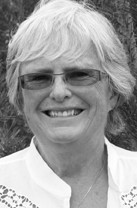Alamosa Landscapes: Non-native shrubs with altitude

That’s correct – altitude! You can easily find United States Department of Agriculture hardiness zone ratings for plants, but not always their altitude preferences. Fortunately, the Colorado State University Extension service has informative and free fact sheets that you can download. I looked up non-native “Trees and Shrubs for Mountain Areas – 7.423”. Alamosa’s elevation is 7543 feet. The fact sheet lists shrubs for mountain areas above 6,500 ft.
While our yard is still deep in snow, even with Sunday’s thaw, I thought I’d report on how non-natives from CSU’s list have fared in our garden over the years.
One of my favorites is Cheyenne mock orange (Philadelphus lewisii ‘Cheyenne’ -- up to 9.000 ft.). It has beautiful white, fragrant flowers in early summer. I have two. The older one is about 6 ft. tall now and I love it all season long. Once established it is xeric. It was a Plant Select* choice for 2001.
Forsythia (Forsythia x hybrid – up to 7,500 ft.) blooms bright yellow before much else is awake in the garden. My original plant died a few years ago after topping 8 ft. I have no idea why it was wonderful one year and dead the next. However, I planted two more and they are both doing well, even if remaining much shorter than their predecessor. While its top planting elevation is listed as 7,500 ft., I don’t think that causes a problem for growing in the San Luis Valley (SLV).
I love my Peking cotoneaster (Cotoneaster lucidus acutifolius – up to 10,000 ft.). Various sites say it grows up to 5-8 ft. tall. Mine are a decade old and only 2 ft. tall. Perhaps they were a dwarf variety. Don’t know, but I love their tidy, compact, dense foliage that keeps weeds at bay. They are in a fairly arid, windy part of the garden, so I occasionally soak them. They are reputed to tolerate poor soil. They look wonderful each year and require almost no attention other than a soak.
Blue mist spiraea (Caryopteris x clandonensis – up to 8,500 ft.) is listed as a shrub most places, but mine die back to the ground each year. They have wonderful lavender flowers. It does reseed and sometimes that works better than encouraging older plants. The dry, warm winter of 2018 took a toll on these in our yard. I’ll have to see what comes up this much wetter year. If not much, I’ll buy some more! I’ve had them for more than 25 years.
We’ve had Japanese barberry (Berberis thunbergii -- up to 7,500 ft.) shrubs over the years. I’ve never had them get more than 3-4 ft. tall. While they are prickly, the beautiful purple leaves make them worthwhile -- a nice color contrast in the garden.
A fairly new item in our yard is an ash-leaf spirea (Sorbaria sorbifolia – up to 8,000 ft.) It has fern-like leaves and white plum-like flowers in mid-summer. If I can find another, I’d get one!
I used to have two lovely nannyberries (Viburnum lentago -- up to 8,000 ft.), but they died out after 10 years. I planted a new one last year and will try another this year. White flowers in the spring and nice red-purple leaves in the fall.
There are a few shrubs I haven’t had such good luck with, even though other Valley gardeners have. I’ve tried elderberries (Sambucus canadensis -- up to 8,000 ft.) a few times. OK, I’m stuck on the old movie “Arsenic and Old Lace” that featured elderberry wine. They require medium to high water and I think I may not give them enough.
Two other shrubs folks in the SLV do well with, but I don’t, are ninebark (Physocarpus opulifolius -- up to 8,500 ft.) and Nanking cherry (Prunus tomentosa -- up to 8,500 ft.). I don’t know what the problem is; both require low to medium water which I provide. And my soil is quite good. I’d love tips from anyone who has had success with either of these! Please email me at [email protected]. Thank you in advance!
You can view photos of these shrubs at AlamosaFlowers.net or AlamosaTrees.net. All the photos of ones listed in this column are of our yard, not catalog ‘how they should look.’ Also, these websites are ad-free and information is specific to the SLV.
*Plant Select: Visit plantselect.org to learn about the organization. Their goal is “to create smart plant choices for a new American Landscape inspired by the Rocky Mountain Region.”
“My own preference is for mixed (beds) where there are ...groups of larger shrubs on corners and elsewhere to give shape to the views and to create surprises.” Graham Stuart Thomas, English botanist



